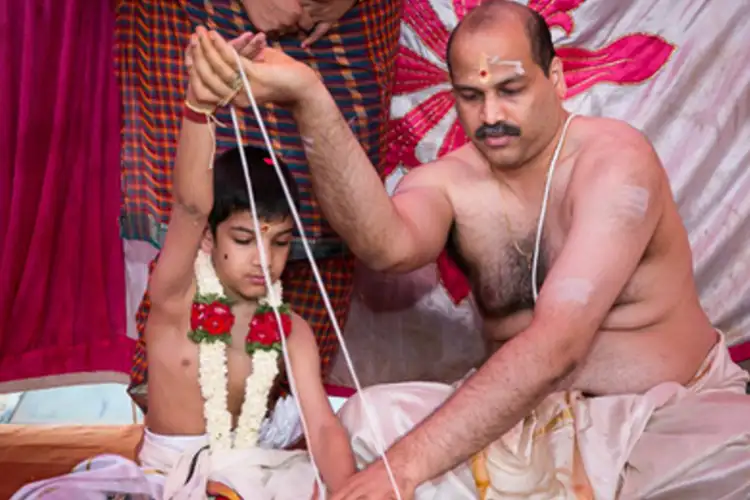Janeu Sanskar: Things You Must Know Before Wearing A Sacred Thread

Janeu Sanskar is also known as Yagnopavita or Upanayana, which is one of the ancient rituals. It is the symbol of acceptance by a student from a mentor. There was a time when gurus used to decide whether their students are allowed to enter the school or not. Yagnopavita is one of the major sanskar among the 16 Vedic sanskaras.
Janeu is a sacred thread received by a young boy from his mentor. This holy thread found on the boy’s left shoulder to the right in such a way that it crosses his chest. Upanayana sanskar is received by a boy when he turns 16. Upanayana itself means to move closer towards the god. This ceremony is organized so that the boy can achieve desired success in their career & professional life. It is believed that by performing this ceremony, a person may get rid of past sins. Janeu sanskar marks the rebirth of the boy participating in this ancient ritual. People believe that Janeu sanskar plays a vital role in the child’s career. In ancient times, young boys would only receive their education after getting Yagnopavita.
Importance of Yagnopavita Sanskar
When a person receives Janeu Sanskar, he needs to wear the sacred thread. This thread is associated with the Trinity of Gods, i.e. Brahma, Vishnu and Mahesh. These three cotton threads are connected with the trio of gods, respectively. According to Vedas, Lord Brahma is the creator of the universe, Lord Vishnu is the provider, and Lord Shiva is the destroyer. And therefore, Janeu (thread) should not get defiled. In case if you lose the sacred thread, then it should be replaced by the new one. Similarly, Yagnopavita means the worshipping of Goddess Gayatri. A person wearing this sacred thread should recite Gayatri Mantra on a daily basis and do Rudraabhishek Puja.
Types of Janeu
Mainly, there are two types of Janeu.
- Three-threaded Janeu
- Six-threaded Janeu
A person who refrains from entering the marriage phase wears a three-threaded Janeu. Whereas, a man who is already married wears a six-threaded janeu as he also requires to wear three more thread of his wife.
Janeu Sanskar In Ancient Times
Upanayana Sanskara means the act of leading to the enlightenment of life. When a boy is accepted by his teacher after the thread ceremony, he will receive knowledge and guidance from his mentor, and he will be free from other life duties. This ceremony marks the second birth of a boy, who will be young-minded and free-spirited.
In ancient times, Yagnopavit Sanskar was organized for every child and his teacher. The child wearing a holy thread is called Yagnopavita or Janeu. This thread ceremony also suggests the starting of formal education in a boy’s life. At present, this ceremony involves people of every age. The practice of janeu sanskar begins from childhood days, and it includes studies of culture, religion, dharma, mathematics, geometry, colours, writing, reading, and traditional values.
Do Girls Take Part In Janeu Sanskar?
Girls who become students by following the rituals of janeu sanskar are called Brahmavadini. They wore the sacred thread over their left shoulder. Other girls who refrain from studying such things would directly get married, and they are known as Sadyovadhu. Some girls who want to take janeu sanskar can also follow the rituals during their marriage ceremony. In this process, young girls wear a holy thread over their left shoulder. In today’s world, many religions allow girls and boys to perform the traditional ceremony of Janeu Sanskar before the beginning of their school days. Some of the Vedic texts, like Asvalayana Grihya Sutra and Yama Smriti, suggest that girls could also start their studies after receiving the Yagnopavita sanskar. Scholars like Gargi and Lopamudra are known for receiving Upanayana sanskar. Besides, Maitreyi, Ghosha, Urvashi, Sachi, and Indrani previously got their janeu sanskar in the history of Hinduism.
Why is Janeu Sanskar organised mainly by Brahmins?
In modern times, if the person is associated with the highest caste, Brahmin, he or she is directly born with the blessings of Lord Brahma. Similarly, Janeu, known as the symbol of sacred thread, belongs to the person connected with an upper caste, Brahmin. However, if we believe in Baudhayana Grihya Sutra, it suggests that every member of our society must take Janeu Sanskar from their gurus.
Learn beyond your Sun sign and Moon sign, Unlock your Premium Janampatri
Janeu Sanskar Should Be Followed Throughout The Lifetime
If a person wearing Janeu gets his holy thread damaged or defiled from any side, he should replace it with the new one.
Many people wearing janeu put it on the right ear whenever they enter washrooms. This is because they believe by putting janeu on their ears may not be defiled.
Once a boy receives his janeu sanskar, he should wear a janeu for a lifetime. One can only remove or change Janeu if the necessity arises. Otherwise, a boy should keep a holy thread on his shoulder for a lifetime.

Wrapping Up
Janeu sanskar is an ancient time ritual that has a significance in person’s life even in modern times. From a very young age, boys start wearing a holy thread before pursuing their education. This sacred thread plays an important role in a person’s educational growth. Once a person gets married, he needs to wear six-threaded janeu throughout their lifetime. Person bounded by this holy thread should take extra care of janeu as it also helps them in smooth circulation of blood.
Talk to our Expert Astrologers First Consultation with 100% Cashback!






